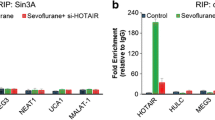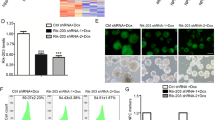Abstract
Sevoflurane could stimulate neurotoxicity and result in postoperative cognitive dysfunction (POCD). Long non-coding RNAs (lncRNAs) have been implicated in the regulation of nervous system disease. This study was performed to investigate role and mechanism of lncRNA Rian (RNA imprinted and accumulated in nucleus) in sevoflurane anesthesia-induced cognitive dysfunction. Mice post-sevoflurane anesthesia showed cognitive impairments and neuronal damage and apoptosis. However, intracerebroventricularly injection with Adenovirus (Ad) for the over-expression of Rian ameliorated sevoflurane-induced neuronal damage and apoptosis. Cognitive impairments induced by sevoflurane were attenuated by injection with Ad-Rian. Moreover, transfection with Ad-Rian also protected isolated primary hippocampal neurons against sevoflurane-induced decrease of cell viability and increase of lactic acid dehydrogenase (LDH) and apoptosis. Mechanistically, Rian bind to miR-143-3p, and decreased expression of LIMK1 (Lim kinase 1) through negative regulation of miR-143-3p. Knockdown of LIMK1 aggravated sevoflurane-induced decrease of cell viability and increase of LDH and apoptosis in neurons, while over-expression attenuated LIMK1 silence-induced neuronal damage post-sevoflurane anesthesia. In conclusion, Rian demonstrated neuroprotective effects against sevoflurane anesthesia-induced cognitive dysfunction through regulation of miR-143-3p/LIMK1 axis, providing promising target for sevoflurane anesthesia-induced cognitive dysfunction.






Similar content being viewed by others
Availability of data and materials
All data generated or analyzed during this study are included in this published article.
References
Monk Terri G, Weldon BC, Garvan Cyndi W, Dede Duane E, van der Aa MT, Heilman Kenneth M, et al. Predictors of cognitive dysfunction after major noncardiac surgery. Anesthesiology. 2008;108(1):18–30. https://doi.org/10.1097/01.anes.0000296071.19434.1e.
Yang W, Kong L-S, Zhu X-X, Wang R-X, Liu Y, Chen L-R. Effect of dexmedetomidine on postoperative cognitive dysfunction and inflammation in patients after general anaesthesia: a PRISMA-compliant systematic review and meta-analysis. Medicine. 2019;98:e15383. https://doi.org/10.1097/MD.0000000000015383.
Yang F, Shan Y, Tang Z, Wu X, Bi C, Zhang Y, et al. The neuroprotective effect of hemin and the related mechanism in sevoflurane exposed neonatal rats. Front Neurosci. 2019;13:537. https://doi.org/10.3389/fnins.2019.00537.
Lin X, Chen Y, Zhang P, Chen G, Zhou Y, Yu X. The potential mechanism of postoperative cognitive dysfunction in older people. Exp Gerontol. 2020;130:110791. https://doi.org/10.1016/j.exger.2019.110791.
Wang W-X, Wu Q, Liang S-S, Zhang X-K, Hu Q, Chen Q-H, et al. Dexmedetomidine promotes the recovery of neurogenesis in aged mouse with postoperative cognitive dysfunction. Neurosci Lett. 2018;677:110–6. https://doi.org/10.1016/j.neulet.2018.03.043.
Li M, Chen C, Zhang W, Gao R, Wang Q, Chen H, et al. Identification of the potential key long non-coding RNAs in aged mice with postoperative cognitive dysfunction. Front Aging Neurosci. 2019;11:181. https://doi.org/10.3389/fnagi.2019.00181.
Zhang Y, Liu Y-X, Xiao Q-X, Liu Q, Deng R, Bian J, et al. Microarray expression profiles of lncRNAs and mRNAs in postoperative cognitive dysfunction. Front Neurosci. 2018;12:694. https://doi.org/10.3389/fnins.2018.00694.
Zhang L, Yan J, Liu Q, Xie Z, Jiang H. LncRNA Rik-203 contributes to anesthesia neurotoxicity via microRNA-101a-3p and GSK-3β-mediated neural differentiation. Sci Rep. 2019;9(1):6822. https://doi.org/10.1038/s41598-019-42991-4.
Chen Y, Zhang Y, Ye G, Sheng C, Kong L, Yuan L. Knockdown of lncRNA PCAI protects against cognitive decline induced by hippocampal neuroinflammation via regulating SUZ12. Life Sci. 2020;253:117626. https://doi.org/10.1016/j.lfs.2020.117626.
Bijkerk R, Au YW, Stam W, Duijs JMGJ, Koudijs A, Lievers E, et al. Long non-coding RNAs Rian and Miat mediate myofibroblast formation in kidney fibrosis. Front Pharmacol. 2019;10:215. https://doi.org/10.3389/fphar.2019.00215.
Yao P, Li Y-L, Chen Y, Shen W, Wu K-Y, Xu W-H. Overexpression of long non-coding RNA Rian attenuates cell apoptosis from cerebral ischemia-reperfusion injury via Rian/miR-144-3p/GATA3 signaling. Gene. 2020;737:144411. https://doi.org/10.1016/j.gene.2020.144411.
Tay Y, Rinn J, Pandolfi PP. The multilayered complexity of ceRNA crosstalk and competition. Nature. 2014;505(7483):344–52. https://doi.org/10.1038/nature12986.
Han K, Sun C, Jia N, Li R, Zhang Z, Zhong Y. miR-143-3p inhibition promotes neuronal survival in an Alzheimer’s disease cell model by targeting neuregulin-1. Folia Neuropathol. 2020;58:10–21. https://doi.org/10.5114/fn.2020.94002.
Zeng X, Liu N, Zhang J, Wang L, Zhang Z, Zhu J, et al. Inhibition of miR-143 during ischemia cerebral injury protects neurones through recovery of the hexokinase 2-mediated glucose uptake. Biosci Rep. 2017;37(4):BSR20170216. https://doi.org/10.1042/BSR20170216.
Yang Z, Lv J, Li X, Meng Q, Yang Q, Ma W, et al. Sevoflurane decreases self-renewal capacity and causes c-Jun N-terminal kinase–mediated damage of rat fetal neural stem cells. Sci Rep. 2017;7(1):46304. https://doi.org/10.1038/srep46304.
Tagawa T, Sakuraba S, Kimura K, Mizoguchi A. Sevoflurane in combination with propofol, not thiopental, induces a more robust neuroapoptosis than sevoflurane alone in the neonatal mouse brain. J Anesth. 2014;28(6):815–20. https://doi.org/10.1007/s00540-014-1822-x.
Chung W, Park S, Hong J, Park S, Lee S, Heo J, et al. Sevoflurane exposure during the neonatal period induces long-term memory impairment but not autism-like behaviors. Pediatr Anesth. 2015;25(10):1033–45. https://doi.org/10.1111/pan.12694.
Chen X, Zhou X, Lu D, Yang X, Zhou Z, Chen X, et al. Aberrantly expressed long noncoding RNAs are involved in sevoflurane-induced developing hippocampal neuronal apoptosis: a microarray related study. Metab Brain Dis. 2016;31(5):1031–40. https://doi.org/10.1007/s11011-016-9838-6.
Yang H, Liang G, Hawkins BJ, Madesh M, Pierwola A, Wei H. Inhalational anesthetics induce cell damage by disruption of intracellular calcium homeostasis with different potencies. Anesthesiology. 2008;109(2):243–50. https://doi.org/10.1097/ALN.0b013e31817f5c47.
Su R, Sun P, Zhang D, Xiao W, Feng C, Zhong L. Neuroprotective effect of miR-410-3p against sevoflurane anesthesia-induced cognitive dysfunction in rats through PI3K/Akt signaling pathway via targeting C-X-C motif chemokine receptor 5. Genes Genom. 2019;41(10):1223–31. https://doi.org/10.1007/s13258-019-00851-5.
Cheng L, Doecke JD, Sharples RA, Villemagne VL, Fowler CJ, Rembach A, et al. Prognostic serum miRNA biomarkers associated with Alzheimer’s disease shows concordance with neuropsychological and neuroimaging assessment. Mol Psychiatry. 2015;20(10):1188–96. https://doi.org/10.1038/mp.2014.127.
Bai Y, Zhang Y, Han B, Yang L, Chen X, Huang R, et al. Circular RNA DLGAP4 ameliorates ischemic stroke outcomes by targeting miR-143 to regulate endothelial–mesenchymal transition associated with blood–brain barrier integrity. J Neurosci. 2018;38(1):32–50. https://doi.org/10.1523/JNEUROSCI.1348-17.2017.
Wang Y, Li G, Zhao L, Lv J. Long noncoding RNA HOTTIP alleviates oxygen-glucose deprivation-induced neuronal injury via modulating miR-143/hexokinase 2 pathway. J Cell Biochem. 2018;119(12):10107–17. https://doi.org/10.1002/jcb.27348.
Xia H, Sun S, Wang B, Wang T, Liang C, Li G, et al. miR-143 inhibits NSCLC cell growth and metastasis by targeting Limk1. Int J Mol Sci. 2014;15(7):11973–83. https://doi.org/10.3390/ijms150711973.
Li D, Hu J, Hongming S, Xu H, Wu C, Zhao B, et al. MiR-143-3p targeting LIM domain kinase 1 suppresses the progression of triple-negative breast cancer cells. Am J Transl Res. 2017;9:2276–85.
Ling H, Ji X, Lei Y, Jia Y, Liu F, Xia H, et al. Diallyl disulfide induces downregulation and inactivation of cofilin 1 differentiation via the Rac1/ROCK1/LIMK1 pathway in leukemia cells. Int J Oncol. 2020. https://doi.org/10.3892/ijo.2020.4968.
Sun L, Guo C, Wang T, Li X, Li G, Luo Y, et al. LIMK1 is involved in the protective effects of bone morphogenetic protein 6 against amyloid-β-induced neurotoxicity in rat hippocampal neurons. J Alzheimer’s Dis. 2014;42(2):543–54. https://doi.org/10.3233/jad-140231.
Todorovski Z, Asrar S, Liu J, Saw NMN, Joshi K, Cortez MA, et al. LIMK1 regulates long-term memory and synaptic plasticity via the transcriptional factor CREB. Mol Cell Biol. 2015;35(8):1316–28. https://doi.org/10.1128/MCB.01263-14.
Zhang N, Ye W, Wang T, Wen H, Yao L. Up-regulation of miR-106a targets LIMK1 and contributes to cognitive impairment induced by isoflurane anesthesia in mice. Genes Genom. 2020;42(4):405–12. https://doi.org/10.1007/s13258-019-00913-8.
Jun X, Huijun W, Feng M, Zhanxue L, Yin B, Yongxing S. MiR-125b-5p inhibitor might protect against sevoflurane-induced cognitive impairments by targeting LIMK1. Curr Neurovasc Res. 2019;16(4):382–91. https://doi.org/10.2174/1567202616666190906145936.
Yu Y, Zhang P, Yan J, Sun Y, Wu X, Xi S, et al. Sevoflurane induces cognitive impairments via the MiR-27b/LIMK1-signaling pathway in developing rats. Inhalation Toxicol. 2016;28(14):731–8. https://doi.org/10.1080/08958378.2016.1266532.
Meng Y, Takahashi H, Meng J, Zhang Y, Lu G, Asrar S, et al. Regulation of ADF/cofilin phosphorylation and synaptic function by LIM-kinase. Neuropharmacology. 2004;47(5):746–54. https://doi.org/10.1016/j.neuropharm.2004.06.030.
Wang Y, Song X, Wang Y, Huang L, Luo W, Li F, et al. Dysregulation of cofilin-1 activity—the missing link between herpes simplex virus type-1 infection and Alzheimer’s disease. Crit Rev Microbiol. 2020;46(4):381–96. https://doi.org/10.1080/1040841X.2020.1794789.
Zuo Z. A novel mechanism for sevoflurane preconditioning-induced neuroprotection. Anesthesiol J Am Soc Anesthesiol. 2012;117(5):942–4.
Zhang L, Zhang J, Dong Y, Swain CA, Zhang Y, Xie Z. The potential dual effects of sevoflurane on AKT/GSK3β signaling pathway. Med Gas Res. 2014;4(1):1–9.
Liao Q, Li R, Zhou R, Pan Z, Xu L, Ding Y, et al. LIM kinase 1 interacts with myosin-9 and alpha-actinin-4 and promotes colorectal cancer progression. Br J Cancer. 2017;117(4):563–71.
Funding
Not applicable.
Author information
Authors and Affiliations
Contributions
YY and WZ designed the study and supervised the data collection, DZ analyzed the data and interpreted the data, and HW, HS, and YZ prepare the manuscript for publication and reviewed the draft of the manuscript. All authors have read and approved the manuscript.
Corresponding author
Ethics declarations
Conflict of interest
The authors state that there are no conflicts of interest to disclose.
Ethical approval
Ethical approval was obtained from the Ethics Committee of The First Affiliated Hospital of Zhengzhou University.
Additional information
Publisher's Note
Springer Nature remains neutral with regard to jurisdictional claims in published maps and institutional affiliations.
Rights and permissions
About this article
Cite this article
Yu, Y., Zhang, W., Zhu, D. et al. LncRNA Rian ameliorates sevoflurane anesthesia-induced cognitive dysfunction through regulation of miR-143-3p/LIMK1 axis. Human Cell 34, 808–818 (2021). https://doi.org/10.1007/s13577-021-00502-6
Received:
Accepted:
Published:
Issue Date:
DOI: https://doi.org/10.1007/s13577-021-00502-6




